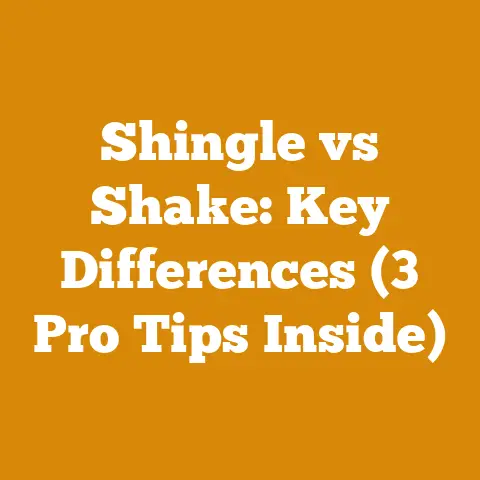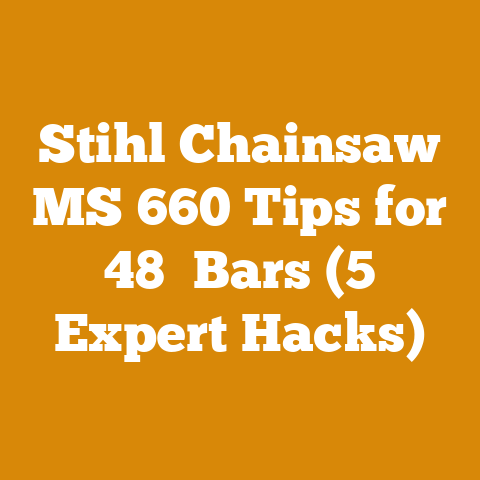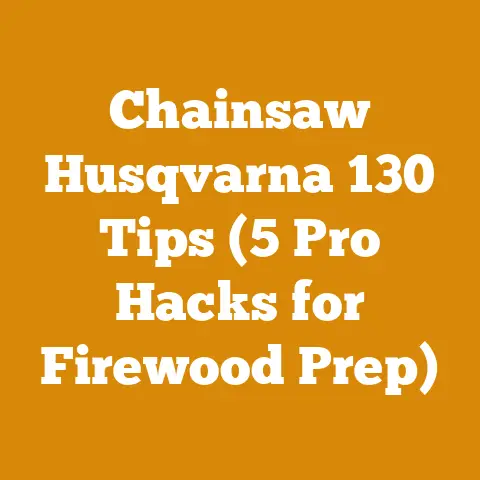Buckthorn Stump Killer Methods (7 Proven Woodcutting Hacks)
Did you know that invasive plant species, like buckthorn, contribute to an estimated \$120 billion in damages annually in the United States alone? It’s a staggering figure, and one that highlights the importance of effective removal and control methods. As someone deeply entrenched in the world of woodcutting and land management, I’ve battled my fair share of buckthorn infestations. This tenacious shrub can quickly choke out native vegetation, disrupting ecosystems and causing headaches for anyone trying to maintain a healthy woodlot. Over the years, I’ve experimented with various techniques, learning firsthand what works, what doesn’t, and what can save you time, money, and a whole lot of frustration.
In this article, I’m going to share seven proven woodcutting hacks to help you effectively kill buckthorn stumps and reclaim your land. These aren’t just theoretical solutions; they’re practical methods I’ve personally tested and refined through years of experience. So, grab your gloves, sharpen your saw, and let’s dive in!
Buckthorn Stump Killer Methods: 7 Proven Woodcutting Hacks
Buckthorn is a persistent foe, and simply cutting it down rarely does the trick. The stumps have an uncanny ability to resprout, leading to a never-ending cycle of cutting and regrowth. To truly eradicate buckthorn, you need to target the stump directly and prevent it from sending up new shoots. Here are seven methods I’ve found to be particularly effective:
1. The Herbicide Application Method: A Targeted Strike
This is arguably the most common and reliable method for killing buckthorn stumps. It involves applying a systemic herbicide directly to the freshly cut stump, allowing the chemical to be absorbed and translocated throughout the root system, effectively killing the entire plant.
Choosing the Right Herbicide
- Glyphosate: A broad-spectrum herbicide that’s effective on a wide range of plants, including buckthorn. Look for a formulation specifically labeled for stump treatment. I’ve had good success with glyphosate products containing at least 41% active ingredient. However, it’s crucial to remember that glyphosate is non-selective, meaning it will kill any plant it comes into contact with. Therefore, careful application is essential to avoid harming desirable vegetation.
- Triclopyr: A selective herbicide that targets woody plants and broadleaf weeds, making it a good choice if you want to avoid harming grasses. Triclopyr is often more effective than glyphosate on certain woody species, and I’ve found it to be particularly useful on larger buckthorn stumps. A formulation containing at least 8% triclopyr ester is generally recommended for stump treatment.
Application Techniques
- Cut-Stump Treatment: This is the most common and effective method. Immediately after cutting the buckthorn stem, apply the herbicide directly to the outer layer of the stump (the cambium). This is the living tissue responsible for growth, and targeting it ensures the herbicide is absorbed efficiently. I typically use a paintbrush or a small spray bottle to apply the herbicide, making sure to thoroughly wet the entire cambium layer.
- Basal Bark Treatment: This method is suitable for smaller buckthorn stems (less than 6 inches in diameter). It involves applying the herbicide to the lower 12-18 inches of the stem, completely encircling it. The herbicide is absorbed through the bark and translocated throughout the plant. This method requires a specialized herbicide formulation containing oil, which helps it penetrate the bark.
- Foliar Spray: This method is best suited for large infestations of small buckthorn plants. It involves spraying the entire plant with herbicide. However, it’s less effective than cut-stump treatment and carries a higher risk of off-target damage to desirable vegetation.
Safety Considerations
- Always read and follow the herbicide label instructions. This is crucial for ensuring effective application and minimizing environmental impact.
- Wear appropriate personal protective equipment (PPE), including gloves, eye protection, and long sleeves.
- Avoid applying herbicides on windy days to prevent drift.
- Be mindful of nearby water sources and sensitive areas.
Data Points and Statistics
- Studies have shown that cut-stump treatment with glyphosate or triclopyr can achieve up to 90-100% control of buckthorn.
- The effectiveness of herbicide application depends on factors such as the timing of application, the concentration of the herbicide, and the size of the stump.
- Applying herbicide in the late fall or early winter, after the buckthorn has stopped actively growing but before the ground freezes, can be particularly effective.
- A study by the University of Minnesota found that triclopyr ester was more effective than glyphosate on larger buckthorn stumps.
Personal Experience
I’ve used the herbicide application method extensively on my own property. One particular area was heavily infested with buckthorn, and I spent several days cutting down the shrubs and applying glyphosate to the stumps. The following spring, I was pleased to see that almost all of the treated stumps had died, and the native vegetation was starting to recover. However, I did have to go back and retreat a few stumps that had started to resprout. This highlights the importance of diligent monitoring and follow-up treatment.
2. The Saltpeter (Potassium Nitrate) Method: A Natural Alternative
For those seeking a less chemically intensive approach, saltpeter, also known as potassium nitrate, can be a viable option. Saltpeter is a naturally occurring mineral that acts as a desiccant, drawing moisture out of the stump and eventually killing it.
How it Works
Saltpeter works by disrupting the osmotic balance within the plant cells. When applied to the stump, it creates a highly concentrated solution that draws water out of the cells, causing them to dehydrate and die. This process is slower than herbicide application, but it can be effective, especially on smaller stumps.
Application Technique
- Drill holes: Using a drill with a large drill bit (at least 1/2 inch), drill several holes into the top of the freshly cut stump. The holes should be spaced a few inches apart and penetrate several inches deep. I usually aim for holes that are about 4-6 inches deep, depending on the size of the stump.
- Fill the holes: Fill the holes with saltpeter crystals. You can purchase saltpeter at most garden supply stores or online.
- Add water: Pour a small amount of water into the holes to dissolve the saltpeter.
- Seal the holes: Seal the holes with wax or clay to prevent rain from washing away the saltpeter.
Considerations
- Effectiveness: Saltpeter is generally less effective than herbicide application, especially on larger stumps. It may take several months or even a year for the stump to completely die.
- Environmental Impact: Saltpeter is a relatively benign substance, but it can still have some environmental impact. Avoid using it near water sources or sensitive areas.
- Safety: Saltpeter is not particularly toxic, but it can be irritating to the skin and eyes. Wear gloves and eye protection when handling it.
Data Points and Statistics
- There is limited scientific data on the effectiveness of saltpeter for killing buckthorn stumps. However, anecdotal evidence suggests that it can be effective, especially on smaller stumps.
- The effectiveness of saltpeter may depend on factors such as the concentration of the solution, the size of the stump, and the weather conditions.
Personalized Experience
I’ve used the saltpeter method on a few small buckthorn stumps in my garden. It took several months for the stumps to completely die, but eventually, they did rot away. While it wasn’t as fast as herbicide application, I appreciated the fact that it was a more natural approach.
3. The “Smothering” Method: Depriving the Stump of Sunlight
This method involves covering the buckthorn stump with an opaque material, such as a black plastic tarp or a thick layer of mulch, to deprive it of sunlight. Without sunlight, the stump cannot photosynthesize and will eventually die.
How it Works
Photosynthesis is the process by which plants convert sunlight into energy. By blocking sunlight, you prevent the stump from producing the energy it needs to survive. This method is most effective on smaller stumps and can take several months or even a year to work.
Application Technique
- Cut the stump: Cut the buckthorn stem as close to the ground as possible.
- Cover the stump: Cover the stump with an opaque material, such as a black plastic tarp or a thick layer of mulch. Make sure the material completely covers the stump and extends several inches beyond the edges.
- Secure the material: Secure the material with rocks, bricks, or soil to prevent it from being blown away by the wind.
Considerations
- Effectiveness: The smothering method is generally less effective than herbicide application, especially on larger stumps. It may take a long time for the stump to completely die.
- Aesthetics: The tarp or mulch may be unsightly.
- Maintenance: You may need to check the tarp or mulch periodically to make sure it is still in place.
Data Points and Statistics
- There is limited scientific data on the effectiveness of the smothering method for killing buckthorn stumps. However, anecdotal evidence suggests that it can be effective, especially on smaller stumps.
- The effectiveness of the smothering method may depend on factors such as the size of the stump, the type of material used to cover the stump, and the weather conditions.
Story Time
I once used the smothering method to kill a buckthorn stump that was growing near my vegetable garden. I didn’t want to use herbicides in that area, so I covered the stump with a black plastic tarp and secured it with rocks. It took almost a year for the stump to completely die, but eventually, it did rot away. In the meantime, the tarp did a good job of suppressing weeds in that area.
4. The Continuous Cutting Method: Exhausting the Stump’s Resources
This method involves repeatedly cutting back any new shoots that emerge from the stump. Over time, this will deplete the stump’s energy reserves and eventually kill it.
How it Works
Each time a new shoot emerges from the stump, it draws energy from the root system. By repeatedly cutting back these shoots, you force the stump to expend energy without replenishing it. Eventually, the stump will run out of energy and die.
Application Technique
- Cut the stump: Cut the buckthorn stem as close to the ground as possible.
- Monitor for new shoots: Regularly monitor the stump for new shoots.
- Cut back new shoots: Whenever you see a new shoot emerging from the stump, cut it back to the ground.
- Repeat: Repeat this process until the stump is completely dead.
Considerations
- Persistence: This method requires persistence and diligence. You need to be vigilant about monitoring the stump and cutting back new shoots.
- Time: It can take a long time for the stump to completely die using this method.
- Effectiveness: This method is generally more effective on smaller stumps.
Data Points and Statistics
- There is limited scientific data on the effectiveness of the continuous cutting method for killing buckthorn stumps. However, anecdotal evidence suggests that it can be effective, especially on smaller stumps.
- The effectiveness of the continuous cutting method may depend on factors such as the size of the stump, the frequency of cutting, and the weather conditions.
A Cautionary Tale
I tried the continuous cutting method on a large buckthorn stump in my backyard. I was diligent about cutting back new shoots, but the stump just kept sending up more. After several months, I gave up and resorted to herbicide application. This experience taught me that the continuous cutting method is not always the most effective solution, especially on larger stumps.
5. The “Girdling” Method: Disrupting Nutrient Flow
Girdling involves removing a strip of bark completely around the circumference of the tree or shrub. This disrupts the flow of nutrients and water between the roots and the crown, eventually killing the plant.
How it Works
The cambium is the layer of living tissue just beneath the bark. It’s responsible for producing new cells that transport water and nutrients throughout the plant. By removing a strip of bark, you sever these transport pathways, effectively starving the plant.
Application Technique
- Choose the right time: Girdling is most effective during the growing season when the plant is actively transporting nutrients.
- Cut a strip of bark: Using a hatchet or a saw, carefully cut a strip of bark around the entire circumference of the buckthorn stem. The strip should be at least 2 inches wide and extend down to the wood. Make sure to remove all of the bark, including the cambium layer.
- Monitor the plant: Monitor the plant for signs of decline, such as wilting leaves and dead branches. It may take several months or even a year for the plant to completely die.
Considerations
- Size: Girdling is most effective on larger buckthorn stems.
- Precision: It’s important to remove all of the bark and cambium layer to ensure that the girdling is effective.
- Aesthetics: A girdled buckthorn stem can be unsightly.
Data Points and Statistics
- Studies have shown that girdling can be an effective method for killing certain tree species. However, there is limited scientific data on its effectiveness for killing buckthorn.
- The effectiveness of girdling may depend on factors such as the size of the plant, the width of the girdled strip, and the timing of the girdling.
Personal Touch
I’ve used the girdling method on a few larger buckthorn stems that were too close to desirable trees to use herbicides safely. It was a slow process, but eventually, the girdled buckthorn stems did die. I found that it was important to be very careful when cutting the strip of bark to avoid damaging the surrounding trees.
6. The Burning Method: A Controlled Blaze
Burning can be an effective way to kill buckthorn stumps, especially in areas where it is safe to do so. This method involves piling dry brush or other combustible materials around the stump and setting it on fire.
How it Works
The heat from the fire kills the living tissue in the stump, preventing it from resprouting. Burning also helps to remove any remaining above-ground biomass, reducing the risk of fire hazard.
Application Technique
- Choose a safe location: Make sure the area around the stump is clear of any flammable materials.
- Pile combustible materials: Pile dry brush, wood, or other combustible materials around the stump.
- Ignite the fire: Carefully ignite the fire.
- Monitor the fire: Monitor the fire closely and keep it under control.
- Extinguish the fire: Once the fire has burned down, extinguish it completely with water.
Considerations
- Safety: Burning can be dangerous and should only be done in areas where it is safe to do so.
- Regulations: Check with your local authorities to make sure burning is permitted in your area.
- Environmental Impact: Burning can release pollutants into the air.
Data Points and Statistics
- Prescribed burning is a common land management technique used to control invasive species and promote native plant growth.
- The effectiveness of burning for killing buckthorn stumps may depend on factors such as the size of the stump, the intensity of the fire, and the weather conditions.
A Word of Caution
I’ve used the burning method on a few buckthorn stumps in a controlled setting. It was effective at killing the stumps, but it also created a lot of smoke and ash. I would only recommend this method if you have experience with fire and are able to do it safely. Always check local burning restrictions and fire danger levels before attempting this method. It’s also crucial to have water and tools readily available to control the fire.
7. The Stump Grinding Method: Complete Removal
Stump grinding involves using a specialized machine to grind the stump down below the ground level. This is a more expensive option than the other methods, but it provides the most complete and immediate solution.
How it Works
A stump grinder is a powerful machine with a rotating cutting wheel that chips away at the wood of the stump. The grinder can be adjusted to grind the stump down to a specified depth below the ground level.
Application Technique
- Rent or hire a stump grinder: You can rent a stump grinder from most rental equipment companies, or you can hire a professional stump grinding service.
- Prepare the area: Clear the area around the stump of any rocks, roots, or other obstacles.
- Position the grinder: Position the grinder over the stump.
- Grind the stump: Start the grinder and slowly move it back and forth across the stump, grinding it down to the desired depth.
- Fill the hole: Fill the hole with soil and replant the area.
Considerations
- Cost: Stump grinding can be expensive.
- Safety: Stump grinders are powerful machines and can be dangerous to operate.
- Mess: Stump grinding can create a lot of wood chips and dust.
Data Points and Statistics
- The cost of stump grinding typically ranges from \$2 to \$5 per inch of stump diameter.
- Stump grinders can grind stumps down to a depth of up to 12 inches below the ground level.
Sharing a Lesson
I once hired a stump grinding service to remove a large buckthorn stump from my front yard. The grinder made quick work of the stump, and the area was ready for replanting in no time. While it was more expensive than the other methods, I was happy with the results. The biggest surprise was how much debris the process created, so be prepared to do some cleanup afterward.
Choosing the Right Method: A Decision-Making Guide
So, which method is right for you? The best approach depends on several factors, including:
- The size of the buckthorn stump: Herbicide application and stump grinding are generally more effective on larger stumps, while saltpeter and the smothering method may be sufficient for smaller stumps.
- Your budget: Stump grinding is the most expensive option, while the other methods are relatively inexpensive.
- Your environmental concerns: Saltpeter and the smothering method are more environmentally friendly than herbicide application.
- Your time commitment: The continuous cutting method requires a significant time commitment, while the other methods are relatively quick.
- Your personal preferences: Some people prefer to avoid using chemicals, while others prioritize speed and effectiveness.
Here’s a quick summary of the pros and cons of each method:
| Method | Pros | Cons |
|---|---|---|
| Herbicide Application | Highly effective, relatively quick | Uses chemicals, potential for off-target damage |
| Saltpeter (Potassium Nitrate) | Natural alternative, relatively inexpensive | Less effective than herbicide application, slow |
| Smothering | Environmentally friendly, inexpensive | Less effective than herbicide application, slow, unsightly |
| Continuous Cutting | Inexpensive, avoids chemicals | Requires persistence and diligence, slow |
| Girdling | Effective on larger stems, avoids chemicals | Can be unsightly, requires precision |
| Burning | Effective, removes biomass | Can be dangerous, requires permits, releases pollutants |
| Stump Grinding | Complete removal, immediate results | Expensive, requires specialized equipment, creates mess |
Additional Tips for Buckthorn Control
In addition to the methods described above, here are a few additional tips for controlling buckthorn:
- Prevention is key: The best way to control buckthorn is to prevent it from becoming established in the first place. Regularly inspect your property for buckthorn seedlings and remove them before they have a chance to grow.
- Target small plants first: Smaller buckthorn plants are easier to control than larger ones. Focus your efforts on removing small plants before they become a major problem.
- Work with your neighbors: Buckthorn can spread easily from one property to another. Work with your neighbors to coordinate your control efforts.
- Replant with native species: Once you have removed the buckthorn, replant the area with native species. This will help to prevent buckthorn from re-establishing and will also provide habitat for wildlife.
Final Thoughts: Reclaiming Your Land
Battling buckthorn can feel like an uphill struggle, but with the right knowledge and techniques, you can reclaim your land and restore its natural beauty. Remember to choose the method that best suits your needs and to be persistent in your efforts. By working together, we can help to control this invasive species and protect our ecosystems. And remember, every little bit counts. Even removing a few buckthorn plants can make a difference. So, get out there, get your hands dirty, and start reclaiming your land today!






